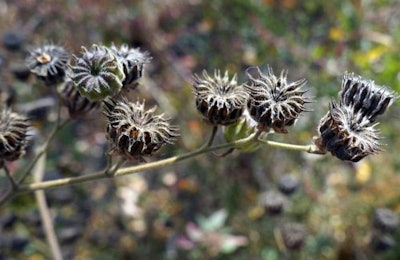
Farmers in Waikato, New Zealand, are the latest to have discovered velvetleaf, a highly invasive weed in corn fields, reports Stuff. So far this year, more than 200 farms across the country have reported finding the plant.
According to the Ministry for Primary Industries (MPI), velvetleaf has been found in fodder beet crops throughout New Zealand. Causing rising concern is the more recent appearance of the plant in corn in Waikato.
Despite an absence of hard evidence, poultry have blamed for the emergence of the plant. It has been proposed that the weed seeds contaminated corn from other countries imported for poultry feed, and passed intact into the manure that was spread onto the beet and corn fields as a fertilizer, according to a report in World-Grain.
However, MPI and the Poultry Industries Association describe this theory as “speculation.”
“MPI would be fairly confident that imported grain for chicken feed wouldn’t be the source because all imported maize grain was heavily processed,” said MPI plant germ plasm imports team manager, Kathryn Hurr. “That system mitigated any risks from biosecurity pests and diseases through milling or heat treatment, which would have destroyed the velvetleaf seed.
“In the investigation we have done, the MPI is confident that processed imported grain is not the source of the current infestation. That investigation looked at the processing, and there’s no record of the seeds remaining viable after the processing.”
There were very strict, detailed processes around importing chicken feed where it was sent to feed mills and turned into pellets, according to PIA Executive Director Michael Brooks.
“Generally that involves grinding, then it involves heat treatment, and then all companies have to testing for finished feed for any viable seed,” said Brooks. “The results from those tests had showed these pellets had no viable velvetleaf seed.”
Why velvetleaf is undesirable
Whatever the source of contamination, concern over the spread of this plant is understandable. Velvetleaf (Abutilon theophrasti) is one of the world’s most invasive pest plants, damaging arable crops by competing with them for nutrients, space and water, according to the MPI. It is an unwanted organism under the Biosecurity Act, and as such, entry to New Zealand is prohibited. Farmers finding velvetleaf on their farm are required to eliminate it.
Velvetleaf is native to south Asia and has become a weed in parts of North America, Europe and Australia. First reported in New Zealand in 1948, velvetleaf has only been reported in the country sporadically until recently.
Furthermore, velvetleaf is toxic to poultry. In a review of weed seeds toxic to poultry, it is stated that velvetleaf seed contamination as low as 2 pounds/ton of finished feed reduced egg production in laying hens and caused deleterious yolk quality changes.

















